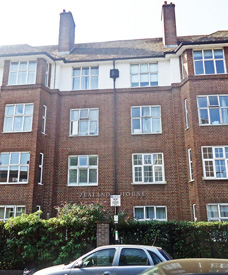Parish Clerks Almshouses Denmark Road, Camberwell, SE5 9EH |
In 1826 Richard Hust, a member of the Worshipful Company of Parish Clerks, in celebrating his 50th year as parish clerk to St George's, Southwark, gave the Company the gift of £100, the annual proceeds of which were to be bestowed upon six of the most distressed widows of members of the Company.
This inspired another member, James Smith, to make more permanent provision for the poor widows in the form of almshouses. (Three centuries previously, there had been seven Parish Clerks Almshouses close by Clerks' Hall, near Bishopsgate, but these had been seized by the King by authority of Parliament in 1528). Others joined him and the Parish Clerks' Almshouse Society was formed. It consisted of various subscribers whose purpose was to build almshouses for the poorer widows of its deceased members.
In 1829 the Society purchased a freehold plot of land in Denmark Road, Camberwell, and building work began.
The Parish Clerks' Almshouses opened in 1830 with accommodation for eight women. Those eligible were widows of such parochial and other clerks of the Church of England who had been subscribers. If no widow applied for a place, then a daughter aged over 50 years could apply. Widows of non-subscribing parish clerks also became eligible for application.
In 1831 the Company lent the Society £250 to pay off the builders. Bequests for the almshouses followed, some under the care of the Society and some under the Company.
The Society, which had a constitution separate from the Company, was managed by its subscribers, who also elected the almswomen.
In 1848 the almswomen received an annual stipend of £2, as well as half a ton of coals.
In 1857 the pension was doubled to £4.
In 1870, as well as the half ton of coal provided by the Society, the Company provided another half ton. The pensions received by the almswomen varied from time to time, from £22 17 shillings (£22.85) to £24 for widows, and from £10 to £14 for daughters, according to the number of inmates. The rates, taxes, insurance and the cost of any repairs to the buildings were met by the annual subscriptions of members of the Society.
In 1930, the Parish Clerks Company sold the 100-year-old buildings and their site to Lambeth Borough Council.
Current status
The site now contains Zealand House, an apartment block built in the 1930s.N.B. Photographs obtained in September 2020

Zealand House.
Interestingly, the road was heavily blitzed during WW2 (1939-1945), but Zealand House was one of the few properties that was only lightly damaged. The district was redeveloped after the war, with Zealand House standing out as the only surviving pre-war property.

The central section of the block bears the name 'Zealand House'.
References (Accessed 15th November 2021)
(Author unstated) 1844 The Metropolitan Charities. London, Samson Low, p. 116.
Allen T 1828 The History and Antiquities of London, Westminster, Southwark and Parts Adjacent. London, Cowie and Strange, pp. 148-149.
Christie J 1893 Some Account of Parish Clerks, More Especially of the Ancient Fraternity (Bretherne and Sisterne) of S. Nicholas, now known as the Worshipful Company of Parish Clerks. London, privately publised, pp. 207-209, 222-224.
Ditchfield PH 1907 The Parish Clerk. London, Methuen.
Low S Jnr 1862 The Charities of London in 1861. London, Samson Low, Son, & Co. p.190-191.
https://boroughphotos.org
https://discovery.nationalarchives.gov.uk
www.londonpicturearchive.org.uk
www.victorianlondon.org
Last updated 15th November 2021
Click here to return to Almshouses of London alphabetical list
Click here to return to home page